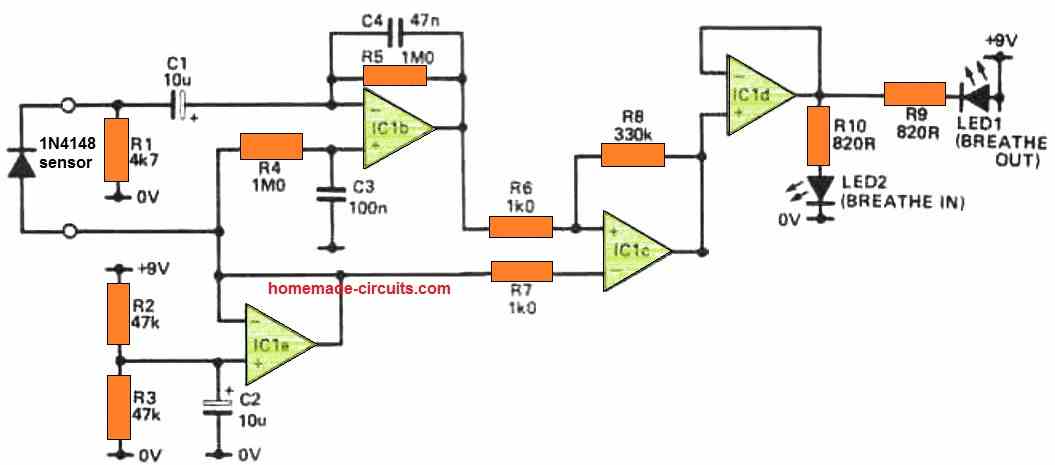The breath detector circuit I have explained below can be used to check or monitor the breathing function of a human or patient.
So I have explained the detailed working of the circuit from the following explanation:
Component Functions
LM324 Op amp: A few operational amplifiers (op-amps) in the circuit magnify the minute voltage changes the diode generates. To make sure the signal is powerful enough for additional processing, op-amps are utilized.
LED indicators: One of the LEDs is utilized to show when exhalation is occurring.
The related op-amp amplifies the temperature change brought on by a human exhaling onto the diode, and if it rises beyond a certain threshold, it activates the exhalation LED.
The presence of this LED acts as a visual cue that someone is exhaling onto the sensor.
The other LED serves as an indicator for inhalation.
The accompanying op-amp amplifies the change in temperature of the breath upon inhalation, which causes the inhalation LED to turn on.
This LED lets you know if someone is breathing in or if they've ceased exhaling onto the sensor.
1N4148 Diode: The 1N4148 diode serves as a temperature sensor in this breath detector circuit, which uses it to track variations in breath temperature. It has two LEDs—one to signify exhalation and the other to signify inhalation—and makes use of op-amps for signal amplification.
The exhalation LED turns on when someone exhales onto the sensor, and the inhalation LED turns on when they inhale or cease exhaling, giving a quick visual indicator of breathing patterns.
Circuit Diagram

How the Circuit Works
The analog breath sensor circuit as shown above, is designed to identify your breathing rate and convert it into a suitable digital signal to power the logic circuitry.
The sensing component of the circuit relies on the fact that exhaled air is significantly warmer than when it was inhaled.
While this principle might require further consideration if you intend to measure breathing rates in the midday sun, it performs effectively indoors during chilly winters, even when the central heating is running at full capacity.
The sensing element is quite ordinary, consisting of a 1N4148 diode (or any other suitable type). Surprisingly, it accomplishes its task without any complications.
The input circuit essentially functions as a differentiator, with its rising frequency response moderated by C4.
The output of this circuit drives a comparator, which, in turn, controls the logic circuitry (enhanced by the Schmitt trigger for sharp signal edges).
The inclusion of an LED circuit is optional; it illuminates one of the diodes based on whether you are inhaling or exhaling, serving as a useful test tool to confirm the proper positioning of the sensing diode and the functionality of the input circuit.
However, it does introduce an additional current draw to the circuit, so the choice of its inclusion is left to your discretion.
The remaining operational amplifier's primary role is to establish a reference point at half the battery voltage for the other integrated circuits.
what are the specifications of resistors uesd?
All are 1/4 watt 5% CFR..